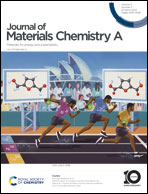Hierarchical flower-like MoS2/reduced graphene oxide nanohybrids supported on nickel foam as a high-performance electrode material for supercapacitor applications†
Abstract
The inconsistent characteristics of renewable energy sources have led to a continual imbalance between the need and supply of energy. Therefore, developing adequate energy-storage devices might be one solution to this ongoing issue. Supercapacitors are considered as predominant energy storage technologies and power sources to fulfil the energy demands of the modern lifestyle. The present article reports a simple one-pot hydrothermal route to prepare flower-like MoS2/rGO (MG) nanohybrids followed by impregnation on nickel foam to develop the electrode for supercapacitors. The resultant MG-2 nanohybrid possessed a maximum specific capacitance of 2049.90 F g−1 at a current density of 30 mA g−1 and approximately 100% capacitive retention up to 10 000 successive charge–discharge cycles at 660 mA g−1. Quantitative estimations were made to give detailed information on the contribution of the surface capacity and diffusion response to the overall charge-storage mechanism. In addition, a symmetric supercapacitor cell was designed using MG-2 nanohybrid electrodes, which achieved a high specific energy of 192.43 W h kg−1 and specific power of 337.36 W kg−1. The remarkable electrochemical properties were attributed to the peculiar morphology of MG-2 nanohybrid having a distinctive 2D microstructure and minimal equivalent series resistance.

- This article is part of the themed collection: 1D/2D materials for energy, medicine, and devices


 Please wait while we load your content...
Please wait while we load your content...